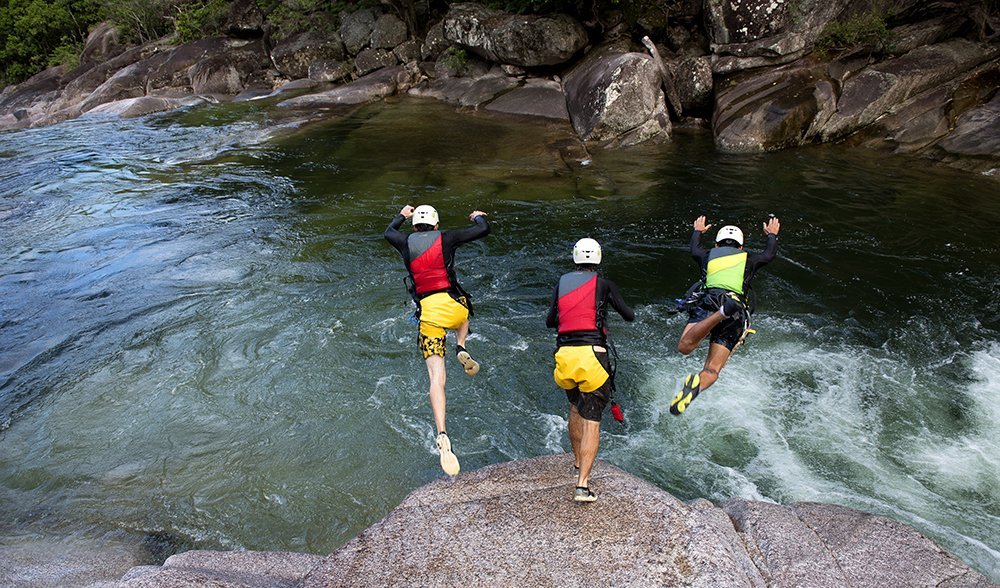Taking the plunge in Tropical North Queensland

MARTY IS DEADLY serious as he looks at us. “You WILL get wet,” he says. The white-water rafting guide then breaks into a smile. “You will have fun… and you WILL get wet.”
It’s only 9am and already the mercury is pushing 35˚C. We’re in Tully Gorge National Park, about 125km south-west of Cairns in Tropical North Queensland. Our only cool relief will be from the river.
It’s February and the Wet season is in full swing – the river is running high and fast. Our raft – one of seven – will be commandeered by Dave McFarlane. The Raging Thunder Adventures guide knows just how powerful the water is, as the Kareeya Hydro Power Station above us is at maximum output, hitting an impressive 88 megawatts. He adjusts our route accordingly.
It’s not just the churning Tully River that has benefitted from the deluge. Across the region, the waterfalls are roaring, the lookouts are lush and, as a cooling afternoon storm rolls in, the sky turns from clear blue to a brooding charcoal.
In the rainforest everything seems alive. Day and night, every bird, bug and frog sings happily among the dripping leaves. The wet tropics are nothing if not loud.
But today, the attention of our helmeted and life-jacketed group of 40 is focused on the boulder-filled Tully River that cuts through the 54,300ha national park.
Today our trip is only 12km, but it’s a wild ride and follows a strict hierarchy. The river, which changes character daily, tells the guide what to do, and he then directs us: paddle forwards, paddle backwards, paddle hard, stop, hold on and – in the big rapids – get down. Sometimes all these instructions are fired in rapid succession. But you’re never doing one for more than five or so seconds, and the rest is gentle drifting – both in and out of the raft, which we sometimes exit involuntarily.

Image: Don Fuchs/Australian Geographic
BEHANA GORGE, about 60km to the north-east, looks similar to the one we just paddled through: steep cliffs, raging water and a steamy day. But here, a raft is useless – what we’ll be descending is like a giant staircase of water.
The gorge is a popular swimming spot for locals and Sam Day has been coming here with his mates since they were teenagers. Now he guides professionally through his Behana Canyoning business, and over the next few hours we treat it as our playground. In a wetsuit top, lifevest and helmet, we leap from ledges into the river, swim against its current, use rocks as waterslides, scoot through chutes and finally abseil down to get to an outcrop that Sam’s offsider Dom Godwin calls Paradise Pool.
“Some people say they like to live life on the edge,” Dom says. “We like to live over the edge.”
But not every water experience in the wet tropics has to be extreme. About 65km south of Cairns, Babinda Creek serves up a beautiful wide pool above the Babinda Boulders, which can be seen only on the Devils Pool Walk, a short 1.3km return track that takes in three viewing platforms along the way. Each shows how the water has both sharpened and smoothed out the granite boulders like an outdoor sculpture park.
Other tranquil swimming hideaways in the region include the 192m Josephine Falls, Alligators Nest at Tully and the Spa Pool, near Cardwell, where the creek runs through a depression in its rocky bed, creating a natural jacuzzi.
Fact box
WHEN TO GO
November to April is the Wet, when the waterfalls and rivers run high and full. The days at this time are hot and steamy: humidity often climbs above 60 per cent and average daily temperatures can regularly reach above 30C, although they are usually tempered by a cooling storm in the evening. The ‘dry’ winter months are more temperate but also much busier.
GETTING THERE
From Cairns, it’s a 90-minute drive to Atherton and the southern Tablelands via either Gordonvale or Mareeba. To the south, Tully is two hours’ drive and Cardwell two-and-a-half.
MORE INFORMATION
- Queensland parks
- Tourism Tropical North Queensland
- Wet Tropics Management Authority
You can read the rest of this feature in the May-June 2017 edition (AG#138) of Australian Geographic.




